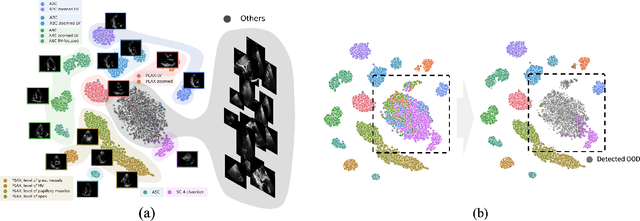Seongmin Ha
Echocardiographic View Classification with Integrated Out-of-Distribution Detection for Enhanced Automatic Echocardiographic Analysis
Aug 31, 2023



Abstract:In the rapidly evolving field of automatic echocardiographic analysis and interpretation, automatic view classification is a critical yet challenging task, owing to the inherent complexity and variability of echocardiographic data. This study presents ECHOcardiography VIew Classification with Out-of-Distribution dEtection (ECHO-VICODE), a novel deep learning-based framework that effectively addresses this challenge by training to classify 31 classes, surpassing previous studies and demonstrating its capacity to handle a wide range of echocardiographic views. Furthermore, ECHO-VICODE incorporates an integrated out-of-distribution (OOD) detection function, leveraging the relative Mahalanobis distance to effectively identify 'near-OOD' instances commonly encountered in echocardiographic data. Through extensive experimentation, we demonstrated the outstanding performance of ECHO-VICODE in terms of view classification and OOD detection, significantly reducing the potential for errors in echocardiographic analyses. This pioneering study significantly advances the domain of automated echocardiography analysis and exhibits promising prospects for substantial applications in extensive clinical research and practice.
Multitask Learning for Multiple Recognition Tasks: A Framework for Lower-limb Exoskeleton Robot Applications
Jun 26, 2023Abstract:To control the lower-limb exoskeleton robot effectively, it is essential to accurately recognize user status and environmental conditions. Previous studies have typically addressed these recognition challenges through independent models for each task, resulting in an inefficient model development process. In this study, we propose a Multitask learning approach that can address multiple recognition challenges simultaneously. This approach can enhance data efficiency by enabling knowledge sharing between each recognition model. We demonstrate the effectiveness of this approach using Gait phase recognition (GPR) and Terrain classification (TC) as examples, the most conventional recognition tasks in lower-limb exoskeleton robots. We first created a high-performing GPR model that achieved a Root mean square error (RMSE) value of 2.345 $\pm$ 0.08 and then utilized its knowledge-sharing backbone feature network to learn a TC model with an extremely limited dataset. Using a limited dataset for the TC model allows us to validate the data efficiency of our proposed Multitask learning approach. We compared the accuracy of the proposed TC model against other TC baseline models. The proposed model achieved 99.5 $\pm$ 0.044% accuracy with a limited dataset, outperforming other baseline models, demonstrating its effectiveness in terms of data efficiency. Future research will focus on extending the Multitask learning framework to encompass additional recognition tasks.
 Add to Chrome
Add to Chrome Add to Firefox
Add to Firefox Add to Edge
Add to Edge